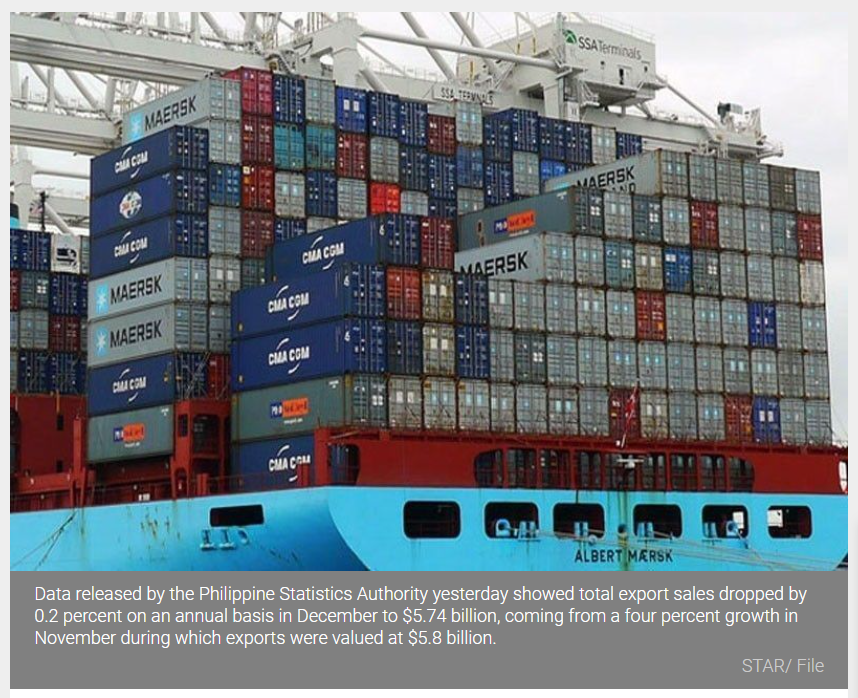Philippines: Exports plunge 10% in 2020
As global economy remains weak
MANILA, Philippines — Exports plunged anew in December after recovering in November, reflecting slower global economic recovery and a severe decline in the outbound shipments of agriculture products.
Data released by the Philippine Statistics Authority (PSA) yesterday showed total export sales dropped by 0.2 percent on an annual basis in December to $5.74 billion, coming from a four percent growth in November during which exports were valued at $5.8 billion.
Month-on-month, earnings from outbound shipments declined by 1.9 percent in December.
This brought the cumulative export earnings for the whole of 2020 to $63.77 billion, a 10.1 percent contraction from total earnings in 2019.
The renewed decline in exports amid the Christmas season may be partly attributed to the slower recovery in the global economy especially in major markets after spikes in new COVID-19 cases in the later part of 2020 led to lockdowns, said Michael Ricafort, chief economist at Rizal Commercial Banking Corp.
“The strongest peso exchange rate in more than four years could have also made Philippine exports more expensive from the point of view of international buyers, amid the COVID-19 pandemic,” he likewise noted.
The weakening of exports to China, as well as the spillover effects of typhoons to exports of farm products also contributed to the slippage in outbound shipments in December, said Nicholas Mapa, senior economist at ING Bank in Manila.
Agri-based exports fell by 46.8 percent in December, reflecting the lingering impact of the series of typhoons that hit the country in November.
“It does appear that the global recovery remains fragile with exports to China turning negative, which was enough to force the entire export sector to dip,” said Mapa.
“One other reason why we saw exports fall may have been due to domestic reasons, with agro-based exports going into freefall, likely due to crop damage from storms in November. Had the storms not hit, we may have been able to service those export orders.”
Imports, meanwhile, contracted for the 20th straight month in December, although at a slower pace of 9.1 percent coming from a decline of 18.3 percent in November.
This was supported by seasonal increases in demand, as well as increases in the prices of some commodities like oil.
“Measures to further reopen the economy also supported the faster monthly growth in imports,” said Ricafort.
This brought the total import value in 2020 to $85.61 billion, a decline of 23.3 percent from the import value of $111.59 billion posted in 2019.
Inbound shipments of capital goods and fuel remained the main sources of contraction in December, indicating slow investment among firms.
“Capital imports continued to be the drag, which suggests that investment activity should stay light in the coming quarters. Fuel imports were also down, showing still lower than pre-pandemic movement and travel,” said Mapa.
A modest gain in consumer imports amid the Christmas season, meanwhile, suggest improvements in consumption as some restrictions were eased, he noted.
With a slower decline in imports, the country’s trade deficit widened to $2.181 billion in December and settled at $21.8 billion for the entire 2020.
Ricafort said external trade would continue to be under pressure from the spread of new COVID-19 strains which could slow down global recovery.
On the upside, increased government spending this year especially on infrastructure will provide a boost to imports and domestic economic activity.
Mapa said the fragile recovery in the global economy would likely limit gains for the export sector.
“Trade trends will likely continue going into 2021 with a fragile global recovery expected to limit particular gains for the export sector while downbeat economic prospects will likely translate to subdued import demand as both firms and households limit investment activity,” said Mapa.
“The net effect of these trends will mean that the 2021 trade deficit remains below the pre-COVID-19 of $3.1 billion, which in turn would be supportive of the peso as corporate demand for the dollar remains soft,” he said.
Source: https://www.philstar.com/business/2021/01/28/2073504/exports-plunge-10-2020


 Thailand
Thailand




